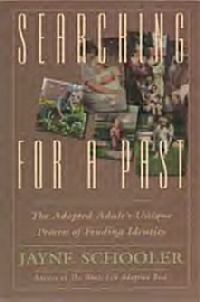
Searching For a Past:
The Adopted Adult’s Unique Process of Finding Identity
by Jayne Schooler
Piñon Press, 1995
Reviewed by Barbara Free
As the subtitle states, Searching For a Past is “The Adopted Adult’s Unique Process of Finding Identity.” Schooler addresses the adoptee’s need for search (or decision not to search) from several different angles, starting with the unique ways adoptees see themselves as they grow up. In the early pages of the book, she states, “Adoption is the only relationship in life that by its very existence creates loss for everyone involved.” Which is not to say that adoption should not exist, but rather is an acknowledgment of the reality that adoption is needed because of loss, and creates other losses by definition.
In explaining many adoptees’ deep sense of loss, Schooler gives examples, told to her by adoptees, of the carried shame and guilt many have, often passed on to them, openly or covertly, by others. One female adoptee said, “I knew my birth mother was only seventeen when I was born. When I was growing up, if I did something really wrong, my father would ask, ’Are you going to be like your mother?’ I lived under such a shadow, if they thought she was so bad, I must be too.” Schooler observes, “The feeling of shame is not about what we did or did not do. It is about our very selves. It is about who we are.”
Schooler spends a fair amount of time exploring the various reasons adoptees search, and Betsie Norris addresses the concept of “curiosity,” which in our culture is interpreted as a trivial desire, not at all what adoptees really feel when they decide to search. It is much deeper than that. One chapter is devoted to ways of telling one’s adoptive parents of the desire/need to search and how to handle that situation. In the past, adoptive parents were told that if they “did a good job,” the adoptee would never want to search. Of course, the decision to search has little or nothing to do with the quality of parenting on the adoptive parents’ part. The next chapter deals with preparing emotionally for the search. Many are not prepared for the intensity of the feelings they may experience, which are often channeled into anger directed at both the birth and adoptive parents, as well as inwardly, and outwardly at agencies, doctors, or whoever the adoptee perceives as having helped to create the situation. Unfortunately, our culture sometime urges people to medicate those feelings because others are uncomfortable with anger, loss, grief, or sadness. Many have found that professionals who are not educated in adoption issues really do not want to see the importance of adoption for the adoptee (or for other triad members, for that matter), and will look for other reasons for the adoptee’s feelings.
Additional chapters deal with the search itself, making the first contact, and handling the information and feelings connected to the initial reunion, and with other possibilities, including finding a birth parent is deceased, having a birth parent refuse contact, having adoptive parents reject the reunion, or finding a dead end (the birth family cannot be fond) even after years of searching. In one example, the adoptee had twice thought she had found her birth mother, met the women and liked them, only to find that neither was the right person. Later, she found that her birth mother had died, at just the age was then turning. She describes her grief and her ways of dealing with it, including taking back part of her birth name and celebrating her birthday. She reports that “the search is complete, but the process is never over.”
Schooler also discusses the unique challenges for those who only learned of their adoption as adults, those who search later in life, and those who need to search while they are still teenagers. Overall, this book, while not long (fewer than 200 pages), is full of good information, presented in a sensitive and rational manner. It would be a good “textbook” for those contemplating search. It is also a good book for those who have already searched by assisting with the exploration of one’s thoughts and feelings about adoption, search and reunion. Although directed at adoptees, it is also a good book to read for adoptive and birth parents, because it will not be as negative an experience to read as several other, similar books aimed at adoptees.
Long out of print, you can purchase a copy online through Amazon.com or one of many used book dealers (see, for example, www.abebooks.com). A copy is also available to borrow from the O.I. Lending Library.
Excerpted from the April 2005 edition of the Operation Identity Newsletter
© 2005 Operation Identity